Rudy Rucker's Blog, page 55
November 9, 2010
William Burroughs in Palm Beach
In the course of my work on The Turing Chronicles, I'm thinking of a scene in which Alan Turing, disguised as William Burroughs goes to the Burroughs parents in Palm Beach, Florida, in January, 1955. And I'm trying to visualize what this would be like.

I found a photo of Mortimer Burroughs with Billy, Jr., on a memorial page, apparently made by a fan or by some people who make a living of creating memorial pages. Mote, as he was called, was born in St. Louis in 1885. So he was seventy in 1955. He lived ten more years.

Mote's wife Laura Lee Burroughs was three years younger, and from Georgia. I found Laura Lee's photo in this cool article, "Like Mother, Like Son," about some books on flower-arranging that she wrote for the Coca-Cola company!
I also learned that the Burroughs home was at 202 Sanford Ave in Palm Beach, here's a satellite view. I've been using the street-view mode on this page to walk around near the house. Palm Beach is this narrow strip of sand with water on the inland side as well.

I'd forgotten that Bill's son William Burroughs, Jr., known as Billy, may have living with the grandparents, which complicates things.
Billy was born in 1947, so he'd be eight in 1955. Our Burroughs did visit his parents in Palm Beach in October, 1954, according to Ted Morgan's biography, Literary Outlaw, p. 251. Wikipedia indicates that Billy Jr. only moved there with grandparents when he was 10, or in 1957, but I'm guessing this is an error.

In any case, I got the location of the house from Billy's third (and posthumous) book, Cursed from Birth, part of which is online. I have his earlier autobiographical novels, Speed and Kentucky Ham. It's kind of a sad story, he died young. Here's a bit from Cursed from Birth about the Palm Beach home.
Mote and Laura moved to Palm Beach so I could grow up wholesome. For ten years, we lived at 202 Sanford Avenue, a street lined with royal palm trees where the houses get smaller and some of them have no servants. My grandparents ran an antique-furniture business on Worth Avenue, Cobblestone Gardens, where they sold elegant antiques to the very rich, and always met them at the door. The house was full of the creaking stuff. Some of the rooms were furnished according to different historical periods, but after Mote was gone, my grandmother sold a lot of it and scrambled up the rest. We had a lot of old Victorian articles with taloned paws carved on the legs; one coffee table actually had wings.
November 6, 2010
Hung the Show. Thoughts on Halloween.
On Friday we had the opening of my art show at the Borderlands Café on Valencia Street in San Francisco. We got about 20 guests for the opening, and the place was full in any case, with a steady flow of hipsters. My artist friends Paul Mavrides and Hal Robbins showed up with some of Hal's fractal-freak friends from NYC, R. U. Sirius was there with a "blotter artist," my son Rudy Jr. was there with his family, fellow Flurb writer Charlie Jane Anders of io9 (and frequent contributor to Flurb) showed up, and my freestyle SF-writer pal Michael Blumlein appeared with his wife and we had dinner together. I shot a video right after hanging the pictures, for what it's worth, here it is.
Borderlands has a pretty good supply of signed prints of my paintings right now, with more coming into stock later this week. I've been making them at home on highest quality Museum Etching paper, 19 x 13 inches, using a Canon Pro9500 inkjet printer with ten colors of ink. Just the paper and ink cost me about $10 per print, and right now we're selling them at Borderlands for, I think, $35 each. You can also buy unsigned prints of my paintings online for a comparable price at rudy.imagekind.com, where you can select various sizes, paper grades and possible frames.

On Halloween, Sylvia and I went walking on Tate Avenue in Los Gatos, which has come, over the years, to be a really popular holiday street. The people who live there go all out with the decorations, and ton of trick-or-treaters turn up. Dig this light-up zombie rising from the grave as a little girl darts past.
Halloween is an odd holiday, kind of unique to the US—it's not exactly like All Saints Day or the Day of the Dead. It's more about facing your most horrible fears and somehow finding them funny, or at least thrilling. And getting candy.
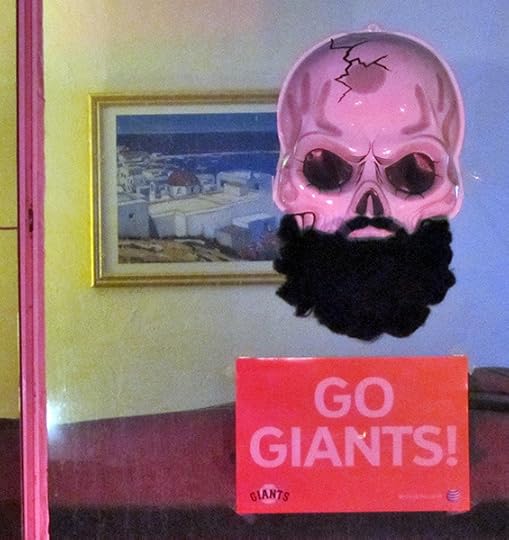
I liked this topical icon of Brian "The Beard" Wilson, the SF Giants' closer pitcher. Though we rarely watch sports, we got into viewing the whole Series. It's surprising how many really close and somewhat arbitrary calls the umps have to make, and interesting that there seems to be no movement towards using instant replays to check the calls on the field. Maybe that would slow things down too much. As it stands, there's an element of "psych" in the calls. It also surprised me how often there are tiny little-known sub-codicils of the rules that come into sway.

After California beat Texas in the series, I was hoping it would be a good omen for the congressional elections. Oh well!

When all else fails, I always like to take a walk in the woods. I'm making good progress on on The Turing Chronicles, I have Alan Turing at the Burroughs family house in Palm Beach right now. Shapeshifter that he is, he's wearing Bill Burroughs's body-form and is trying to tell the Burroughs parents that he's not really Bill, and of course they think he's insane. I think he'll have to bail from there quite soon.
November 2, 2010
Art Show at Borderlands Cafe
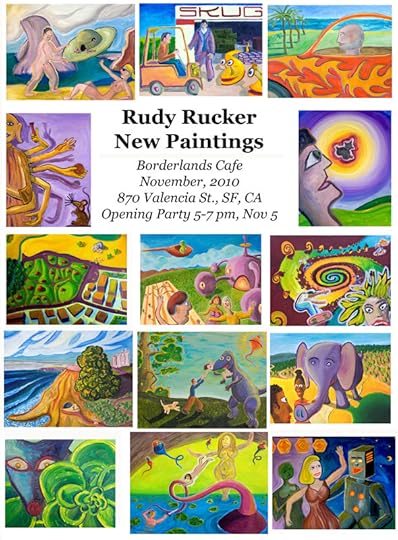
Another art show! Rudy's latest paintings.
It'll run all month, starting November 5 at Borderlands Cafe at 870 Valencia Street in San Francisco. Public parking lot on 21st street.
Opening party is Friday, November 5, from 5 to 7 pm. Join us if you can!
October 30, 2010
High Concept: Shapeshifting With Skugs
I'm working on my Turing novel these days. Lately I've been looking at this recent oil painting of mine, Nude Nabs UFO, that hangs on my office wall. I did a lot of layers on it, and the colors are very rich. Writing can be like that too. You keep adding layers and extra bits until it has this nice patina. That's more along the lines of what literary novelists do—as opposed to frantically rushing on to new special effects and wild surprises, as I'm sometimes prone to do. You can click on the image below to see a larger version.
So what's going on in this chapter anyway? Well, Alan Turing has shapeshifted himself into the form of William Burroughs, is booked onto the Phos tramp steamer from Gibraltar to Miami.
There's a sinister and slimy guy named Neddy Strunk on the ship, and as the Phos nears Miami, Neddy has a confrontation with Alan into his custody. Somehow Neddy knows that Turing has become a shapeshifter, and he wants something from Alan, but Alan loses it and violently throws Strunk over the ship's railing before listening any more. Looking down into the Bahamian waters, Alan sees Neddy's body as a glowing white form that follows the ship for a bit and then dives into the depths like a dolphin.
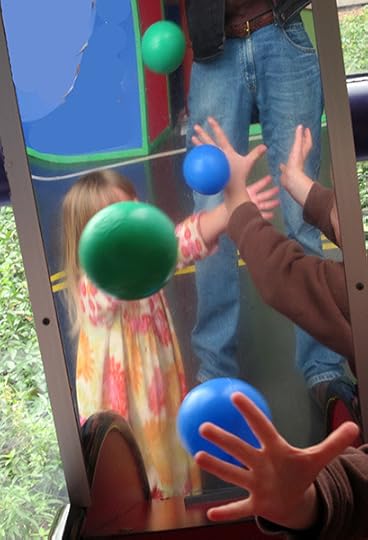
I think Strunk is in fact a shapeshifter like Alan—a human who has become what I'm calling a skug. It may even be that Strunk and the skugified Pratt from my Flurb story, "The Skug," are one and the same, thanks to potency of skug flesh. I might suppose that a chunk of Pratt followed Alan from Tangier to Gibraltar—the thing eats some local in Gibraltar and mutates into the unpleasant Neddy Strunk.
So what does Strunk want from Alan? He wants a wetware upgrade. The skug that Alan used when dissolving Pratt wasn't fully optimized like the skug that Alan used when merging himself with William Burroughs. The Strunk-skug grew from a scrap of Pratt, and doesn't have such good functionality.
Why doesn't Alan welcome the Strunk-skug? I think it's mainly that he doesn't quite understand what Strunk is, and fights with him and throws him overboard before Strunk's skuggy nature comes clear as he glows and swims away. At a deeper level, Alan's repulsion is like that of Dr. Jekyll repelled by the deeds of Mr. Hyde, like the Baron von Frankenstein repelled by his monster, or like an author repelled by his id.
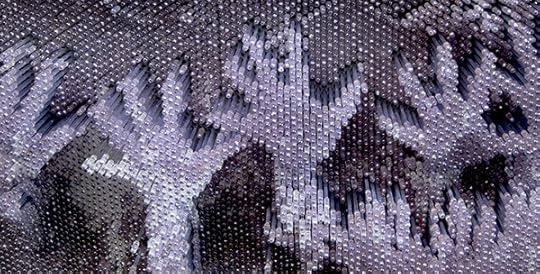
Looking ahead along the story arc, I really would like to know what these mysterious agents and skugs are up to. And what will Turing's goal be? I know from experience that the task in and of itself doesn't have to be all that important or recondite—we're really just talking about a Maguffin. But the reader likes to have a fixed goal in mind.
Backing off for a moment from my thoughts about a goal, I want to think about the "high concept" method of structuring a plot. You make one simple but drastic change in the world that percolates out with many interesting effects. What I'd like to do in The Turing Chronicles is to use shapeshifting via skugs as my high concept.
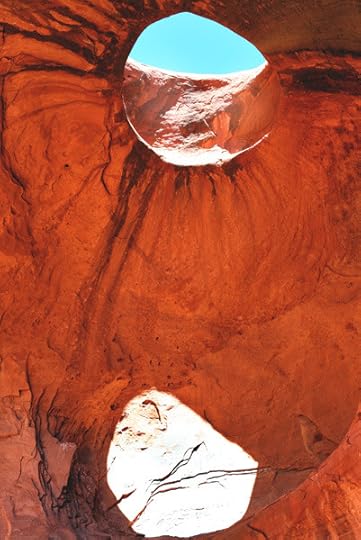
Shapeshifting is a fairly rich metaphor: Universal computation. Transgendering. Artistic creation. Personal growth. Psychosis. And the skugs who potentiate the shapeshifting have the connotation of creativity out of control. The beatniks.
Generally a skug will be integrated with a person and simply be giving them higher powers. Perhaps from time to time a skug can in some sense go rogue and behave like a subhuman—this would represent a kind of curdling in the shapeshifter gift. Some people lose control and become wholly chaotic, devolving into rogue skugs.

Doing some research in my bookcases, I came across a really cool shapeshifter in the form of the character Plastic Man in the Jack Cole comics of the 1940s and early 1950s. In 1999, Art Spiegelman wrote a wonderful New Yorker article "Forms Stretched to Their Limits," about Jack Cole. And later Chip Kidd added Cole's strips and illustrations to the article to make a lovely book, Jack Cole and Plastic Man (Chronicle Books, 2001). I may first heard of Plasticman [sic] in Thomas Pynchon's Gravity's Rainbow—see this cool reference page for that.
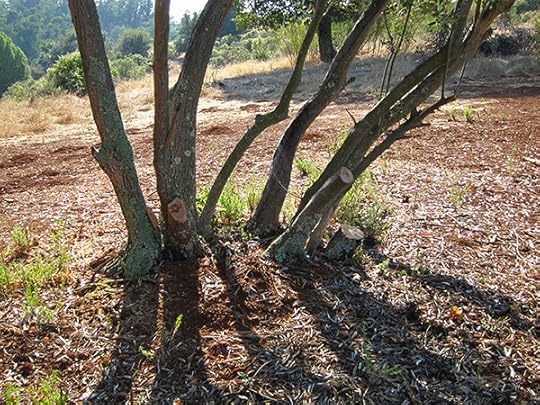
Summing up today's notion of my plot, it's about a guy who invents a method for turning himself into a shapeshifter or, more concisely, a skug. He does shapeshifting for fun, and now and then for commercial gain or for sexual pleasure. He might become a woman, a dog, a big bird. He is able to communicate this skugly power to others, and the shapeshifting spreads. Pretty much everyone at the Six Gallery reading of Ginsberg's "Howl" was a skug. And what orgies they had in those times!
In a nutshell, or, rather, in a tweet, I see my Turing and the skugs story as follows. "Being creative = shapeshifter = skug infection. Art = communicable disease."

Back to story-arc. How does the scientist-created-mutation-story end? I see two models that I'll call Retraction and Repression. In either model, the scientist dies nobly fighting at the end, or perhaps he flips into some unknown new dimension of reality.
(Retraction) The scientist decides it was a mistake and, with great labor, manages to roll back the infestation. In the Retraction story line, the skugs get so freaky that Turing himself realizes they were a mistake, and he labors to undo them.
(Repression) The government or some more free-form group akin to a lynch mob battles to wipe out the mutants. In the Repression story line, the right-wing segments of the government crack down on the skugs.
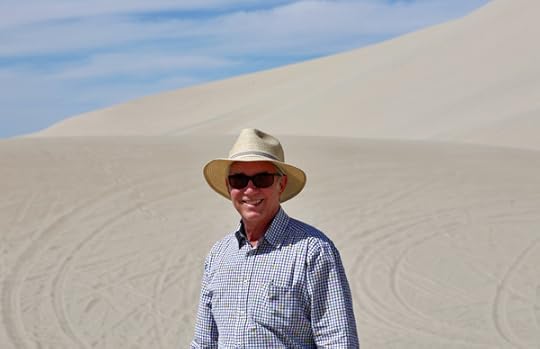
My knee-jerk reaction is to go for the Repression model, because that's closer to how I see our actual society operating. But really the Retraction model offers more dramatic possibilities. We begin with a Repression model, and Turing is defending the skugs from exploitation by the military and making skugness a tool of the intelligentsia. But then the skugs go too far. One might think here of psychedelic drugs—initially they were hailed as tools of psychic liberation, but over time we came to see the drugs burning out some people. We could dial up this notion with the skugs—at some point the skugs could start doing much more harm than good. And then Turing might, albeit reluctantly, join in the crackdown against skugs.

Maybe he Pied Pipers them into a nuclear blast—which would be a very classic 1950s-SF kind of ending. Having grown up in the 1950s, I've always had this moth-like desire to step into the core of an exploding H-bomb…
October 28, 2010
Wild West #9. Expeditions into Monument Valley
Last week I did a telephone interview with Thomas Gideon, who runs a podcast blog called The Command Line. To hear the talk, you can also click the button below to go to my podcast station.
Today I'll continue in my trip-photos mode, with more on Monument Valley.
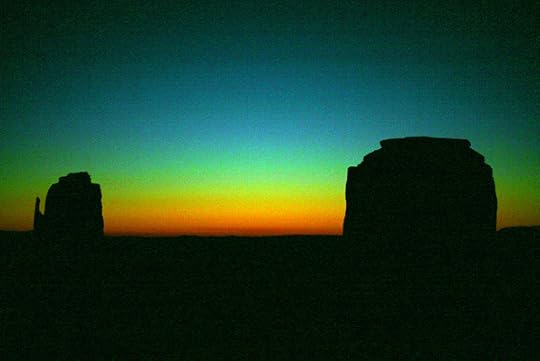
Our room looked out over the valley, and we happened to wake up at dawn, like around 5 am. Unreal. It's amazing how the whole spectrum gets spread out in the sky.

It's possible but maybe a little nerve-wracking to drive your own car into the valley on a fairly whipped gravel road. Instead we signed on for a jeep tour with a young guy called Parker Johnson, whose family runs Majestic Tours. Arranging the tour was fairly casual—there was a booth and a number of guides in the parking lot by the View hotel.
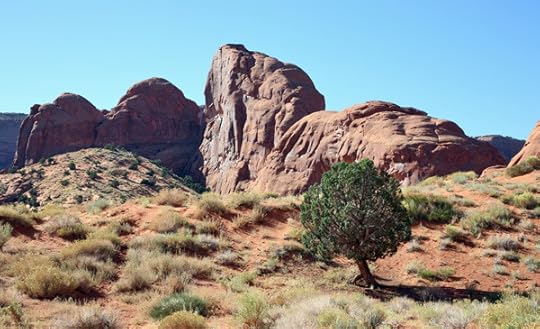
Parker was a good guide. He turned out to be a college student and a big reader, and we talked about books, as well as about the sights. Being with a guide, we were allowed to go deeper into the back corners of the land than we could have gone in our own car. The peace and quiet out there was kind of intoxicating.

We saw a nice petroglyph of a sheep.

The "Eye of the Sun" is a natural formation that takes on the look of a Picasso profile. Parker said the Navahos have gatherings and concerts there, with singing and drums.
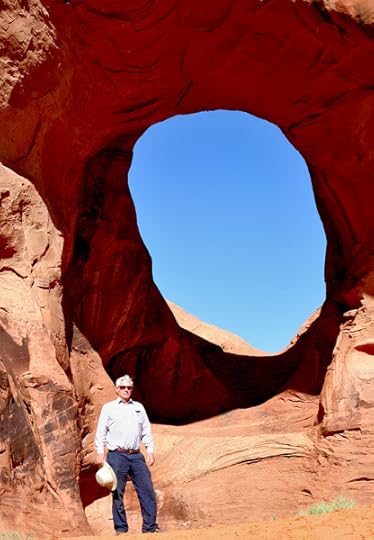
It's partner, the "Ear of the Wind" is great too. A really magical vibe out there.

We came to a formation called the Totem Pole, highly iconic. Amazing how perfectly Nature designs things on her own.
You've seen a lot of these shapes in Hollywood movies. John Ford used to come to Monument Valley for filming. The "Mittens," for instance appear in his movies She Wore a Yellow Ribbon and Fort Apache. And the Totem Pole is in the Clint Eastwood movie, The Eiger Sanction—apparently Clint got the Navahos to let him put some climbing pegs into the tower so he could climb atop it for some shoot-out scene.

So as to have some evening entertainment, the View hotel shows one of those old John Ford movies projected on the wall of the patio every night, and we could see them from our room's window. It was kind of cool to see the landscape in these old black and white films. But after awhile, the movies got a little tiresome with their unenlightened attitudes towards the Native Americans. Those horse-soldiers whom Ford celebrates were, after all, in the business of stealing the land from the locals. And when John Wayne and Henry Fonda start prating on and on about "honor," and calling each other "Mister," it's hard to take.
On our last day at Monument Valley, I got up really early and hiked a trail out to the West Mitten. I started in the dark, as I didn't want to be in the desert once the midday sun came up. Later I YouTubed a video from my pocket camera.
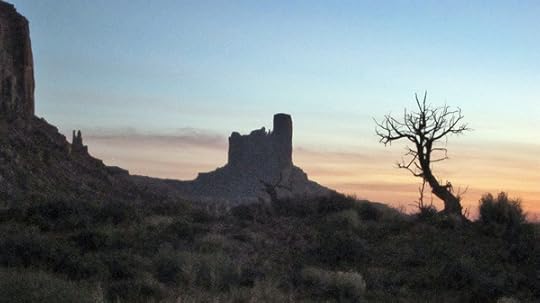
It was about a three hour walk, and I saw no other sign of humans—except for a little complex of sheds, shacks and trailers where a family of Navaho herders lived. Their attitudes about the land seem very cool.

As I mention in the video, To keep me company, I had this cool "fetish" that I bought in the Navaho gift shop, a little pig or, more properly speaking, a javelina. Perfect for me given that, as I've often said, I think of the Pig as my totem animal. "The pig is the most intelligent animal," as I like to say.

I got a some great views of the Krazy Kat landscape out there, and being behind the mitten felt like I was in a secret and sacred space.

And then I'd finished the hike and was back on the sandy road where the cars and jeeps drive.
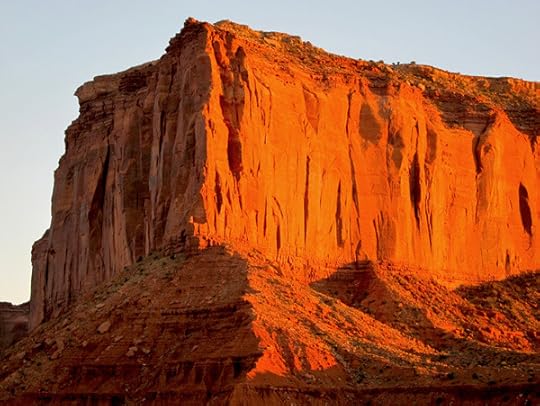
I want to go there again!
October 26, 2010
Wild West #8: To Monument Valley
Back to the Wild West today!

The "Three Gossips" are enormous towers in the Arches park near Moab.

We hiked in and saw the longest arch of all, the Landscape Arch, it's actually debatable how exactly to measure its size, but roughly speaking it's a hundred yards across.

Over the day, Arches gets pretty crowded. On the last morning, we went out early and looked at Double Arch.
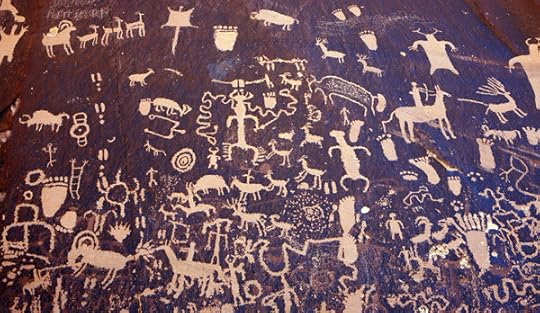
And then we drove south from Moab to Monument Valley, which lies at the border of Utah and Arizona, near the "Four Corners" area. One the way we passed Newspaper Rock. It's hard to date petroglyph markings like this—some say they're a thousand years old, others think it's more like a century. Several of the Native American guides we ran into had the idea that the petroglyphs depicted visiting aliens.
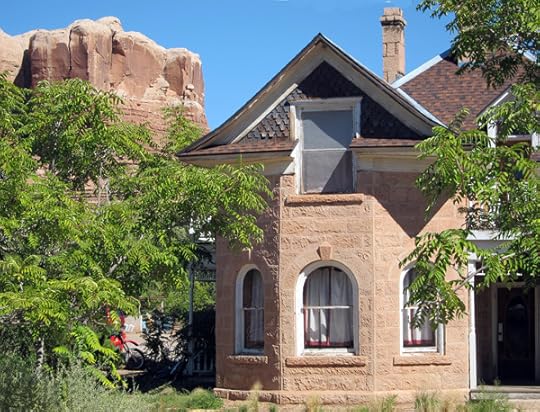
We passed through a few Mormon towns in Southern Utah, ending with Bluff, which has a couple of older Victorian houses that might have been built by Mormon settlers.
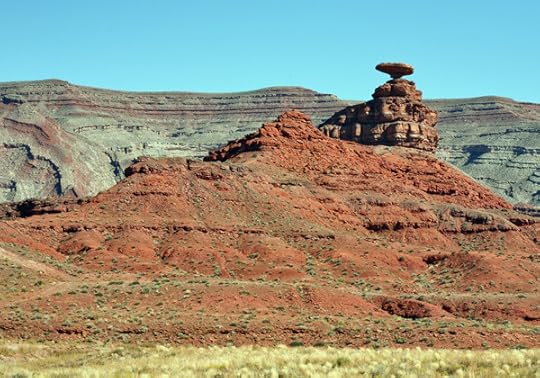
Monument Valley itself lies within a Navaho reservation, and the very last town before the rez is called Mexican Hat, after a stone formation nearby. The reservation is dry; there are a couple of bars in Indian Hat, a gas station, two motels and not much else.
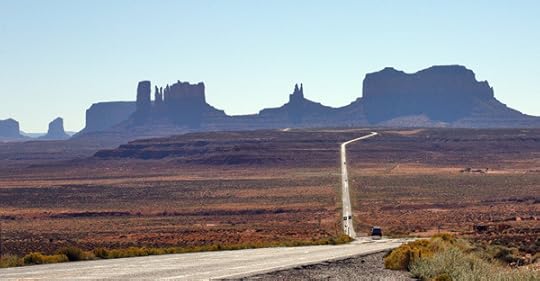
We drove in towards Monument Valley in the late afternoon, it felt epic, like going to Oz.

Monument Valley itself is an expanse some dozen or so miles across, with immense rock formations. Two of them are called the "mittens," as each has a main part and a smaller "thumb."

Monument Valley at dusk. The View hotel is on the left.Click for larger version.
The Navahos recently built a really great hotel called The View on the lip of Monument Valley, and we were able to find a room there—we hadn't been able to reserve, but someone had cancelled. If we hadn't found a room we would have camped in what was basically a red dirt parking lot.
I walked up onto the slopes of a bluff next to the hotel and took a few pictures. Moments like this, I want time to stop.
October 22, 2010
Post-Impressionist SF
Sylvia and I were up in San Francisco two days ago. I visited with my artist friend Paul Mavrides, and then the three of us went to see the show "Post-Impressionist Masterpieces from the Musée d'Orsay" at the de Young museum in Golden Gate Park.
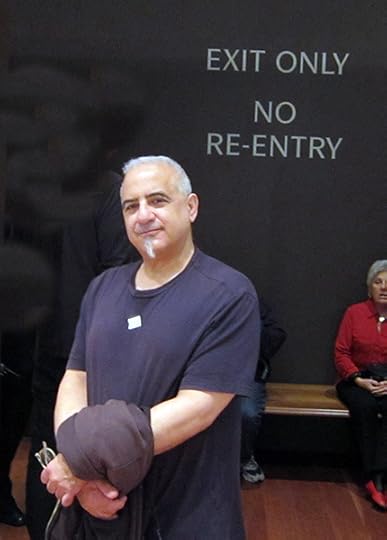
[Paul Mavrides outside the Post-Impressionist art show…he selected this pose.]
I mentioned to Paul my idea of having Turing blunder into the fake town set up by an A-bomb test-site, and Paul said this had been used not only in Indiana Jones and the Kingdom of the Crystal Skull, but also in a 1954 Mickey Rooney comedy called The Atomic Kid, and in the last episode of the first season of a 1986 TV series called Crime Story. I don't think I'll look at either of those, but the fact that the idea's been used three times makes me feel a little more free about using it again. It's kind of a standard trope by now.
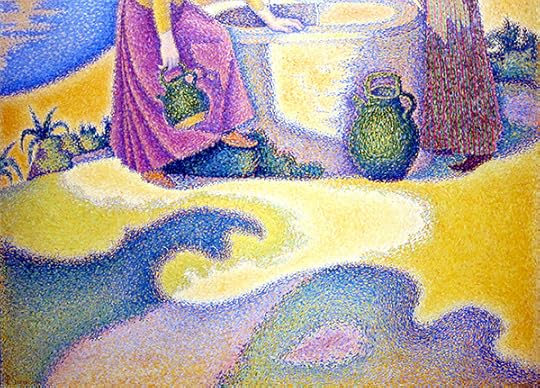
I loved Paul Signac, Women at the Well, of 1893. Some really great gnarly shapes at the bottom. And Beach at Heist by Paul Lemmen, 1892.
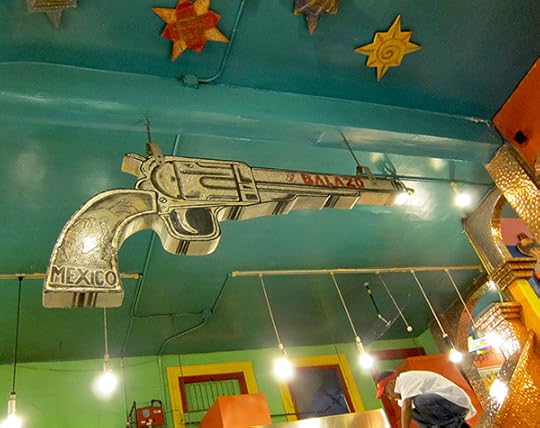
In the evening Sylvia and I went to a reading at Booksmith on Haight Street, and had supper at one of my favorite Mexican restaurants right next door, Balazo (which means pistol in Spanish).
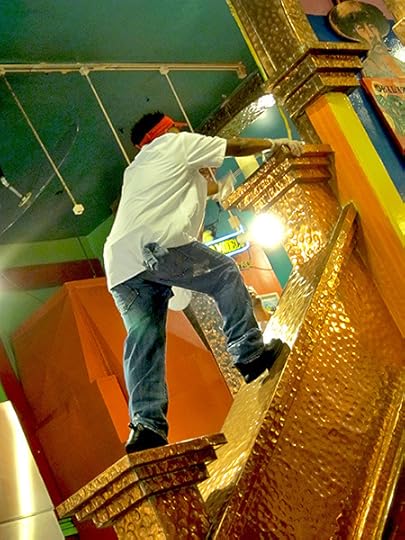
[A guy cleaning the copper trim at Balazo.]
I checked out some big cartoon books at Booksmith, one of which included "Death Sentence," a comic from Tales of Terror #14, March, 1954, with art by Sid Check. A scientist grows some protoplasmic slime in a glass bottle, much like Alan Turing culturing his skug in my novel. By tweaking his culture with I think radiation, the scientist gets the stuff to undergo "forced rapid evolution of 1,000,000 years," effectively becoming a creature typical of the far future. Some of the goo gets into a cut on the scientist's finger and then, "He was a changing, shapeless mass of ulcerative protoplasm." The goo splits and redivides, eating everyone in sight. Perfect.

While at Paul's I glimsed Doctor Hal Robbins in his laboratory. He's gearing up for a new round of his "Ask Dr. Hal" performances.
It was great being in San Francisco at night in the fog. Such a sense of promise and excitement. I hadn't been on Haight Street for about a year, and it looked a little better than I'd remembered—usually I always just go to Valencia Street these days. There really are some good clothes stores on the Haight, the restaurants aren't bad, and there weren't as many gutterpunk panhandlers as usual.

And while I was in town, I checked out the wall space at Borderlands Café on Valencia, planning the arrangement for my art show there in November…next month.
October 19, 2010
Wild West #7. Moab. Alan Turing and the Beats.
I want my character Alan Turing in The Turing Chronicles to make friends with a woman. What if he meets up with an early electronic composer, as he has some facility in that direction thanks to his Delilah analog voice encryption project.
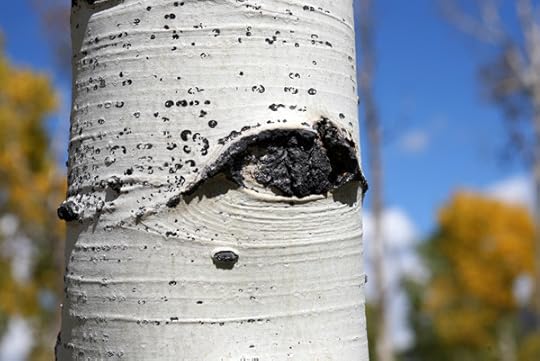
[Today's photos are mostly from around Moab, Utah, and particularly from the Arches National Park, although the photo above is of an aspen near the Flaming Gorge.]
They barely had the phrase electronic music in 1955. They called it musique concrète, see Wikipedia history of electronic music. Some called it acousmatic art, where that weird word means you can't see the source of the sound. They used Ampex tape recorders, sampling natural and manmade sounds (like factory noises and ship sirens and motors) collaging them, speeding them up, slowing them down, echoing and looping. Sometimes playing a tape track with live instruments.
I've been reading the cool book of interviews, Pink Noises for inspiration. One woman in there, Annea Lockwood, taped a burning piano, the mike wrapped in asbestos. And she went the length of the Danube, taping it's various sounds.

[Coming into Moab in driving rain. High plains drifters.]
Burroughs himself was really into tape recordings for a time, come to think of it. Edgard Varèse and Karlheinz Stockhausen were active in the late 40s and early 50s. They had the idea of synthesizing music via electronically produced signals. In the U.S., John Cage was involved with the Music for Magnetic Tape Project. Turing's friend Christopher Strachey wrote a music program for a computer based on an early Manchester computer.
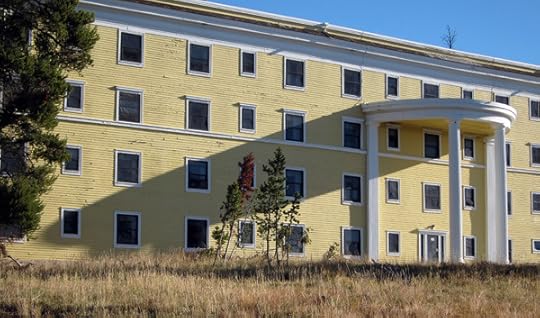
[Earlier: long portico shadow at Yosemite Lake Hotel.]
My fictional character named Judy Green is the woman composer. I'm thinking she's gay, and Turing, who sometimes skug-shapeshifts into a woman named Abby, is pursued by her. The "imitation game" to the second power.
I see Alan Turing (mostly shapeshifted into a simulacrum of William Burroughs, but sometimes looking like Abby) driving from Palm Beach to SF with someone like Neal Cassady. Certainly Neal himself could fit into the story, given that we have Burroughs already. But I feel some uneasiness about writing about Neal. It might be gauche, derivative, dull. I don't want to come across as a Beat fanboy. It would be better to invent my own madman. Make it fresher. Yes, I enjoyed writing the Burroughs chapter, "Tangier Routines," and Burroughs might even come back. But that doesn't mean I have to put in pop-up cameos for every single Beat.

[Gotta love those "hoodoo" formations.]
So okay, the cross-country driver isn't Neal. I recall the name of a character who was just about to make an entrance when I broke off work on a never-finished novel in, I think, 1982. I think his name was Vassar Fogarty. Vassar could be Alan's driver instead of Neal. A (fictional) lesser-known friend of Burroughs's.
And Vassar could be into some soul-sleeping jive along the lines of Neal's Edgar Cayce stuff. Only it's sort of true, and Alan is picking up telepathic or chthonic vibes.
Maybe Turing doesn't like Vassar at first. Vassar's a bumptious blue-collar stoner, and it seems like Alan would have to be sexually attracted to him. But at a personal level, Turing dislikes him initially. He's won over into some intricate mind analysis game. Maybe Vassar gets Turing to be stealing gas and food. And Judy is making music out of it. And using her tape recorder to rob people.

[Pure Wile E. Coyote territory.]
While in Abby form, Alan tells Judy that his friend is getting a ride to SF with another friend, Vassar Fogarty, and Abby can ride along. When Judy gets in the car, it's just Alan and Vassar, and she's uneasy. Vassar wants to have sex with Judy and she's putting him off. Alan calms Judy, and at the edge of town he shapeshifts into Abby. Vassar is impressed. Suppose they go for a sexual three-way that night or the next. Alan/Abby is happy to be getting Vassar's embraces, and Judy's happy to be making it with Abby as well.
It might be interesting, after they get to San Francisco, to have Alan use skug power to swap genitalia with Judy Green. The couple would be a metaphor for a certain kind of man-woman pair. "She wears the pants." Oh, I don't think I'll do that, the readers might not like it. And Alan wants men, not women. He'll get a real boyfriend.

[Ambient gnarl.]
Re. Alan's boyfriend in SF, I figure he's not Allen Ginsberg, for the same reasons why I don't want to use Neal Cassady as a character. But the boyfriend is, I think, an experimental film maker along the lines of
October 16, 2010
Remembering Benoit Mandelbrot
Benoit Mandelbrot burst upon the public stage with his extravagant work of genius: Benoit Mandelbrot, Fractals: Form, Chance and Dimension (W. H. Freeman, San Francisco 1977). As Mandelbrot himself might put it, "I know of very few books … in which so many flashes of genius, projected in so many directions, are lost in so thick a gangue of wild notions and extravagance."
(He made this remark about George Kingsley Zipf's book, Human Behavior and the Principle of Least Effort. The Mandelbrotian word "gangue," more commonly used in French, refers to otherwise worthless material in which valuable ores or gems may be found. It's pronounced like "gang" in English.)

Detail of the MandelCubicWhoopDiDoo Cubic Mandelbrot Set.
Today's illustrations and videos are recycled from my rather long post from April and May, 2010, "Rudy Set as Ultimate Cubic Mandelbrot Set. Quartics & Quintics Too!" That post contains explanations of how the images were computed.
I went to Mandelbrot's house early in 2001, when I was involved in an abortive project to try and make a large screen (IMAX) science movie featuring some huge, prolonged zooms into the Mandelbrot set.
The movie, which was to be about fractals, had the working title Search for Infinity, a title which was dictated by the producer, Jeff Kirsch, director of the San Diego Space Center Museum. Jeff was committed to presenting the film as being about infinity instead of being about fractals, as he felt many more people would be interested in the former than the latter. And in a mathematical sense, fractals are indeed infinite, in that you can zoom into them, forever finding more levels of detail. It's an infinity in the small, rather than an infinity in the large.

Detail of MandelCubicInvasionOfTheHrull
The very talented film maker Ron Fricke (Konaequaatsu and Baraka) was committed to shooting the film, and I was going to write the script. Ron and Jeff were also bent on including Arthur Clarke in the movie as a character. And Ron wanted the movie to star a computer-brained space probe who was afraid to fly off into the endless void of interstellar space. Jeff had scored a development grant for the project from the National Science Foundation and we worked on preparing a final proposal over a couple of years.
Taking all the story constraints into account, I put together ten or eleven successively more refined treatments for a film script, resulting in a fairly reasonable treatment, The Search For Infinity, which you can read online.
But, like so many films, the project was never realized. The sticking point was that we failed to get the needed the million dollar grant from the National Science Foundation. One reason I visited Mandelbrot was in fact to try and win his support in case the NSF were to ask his opinion about the project, but he was unenthused about it, I don't know exactly why. One of his issues was that it was wrong to bill the film as being about infinity, when in truth it was about fractals I agreed with him on this point, but this wasn't something that I could get Jeff and Ron to go along with.
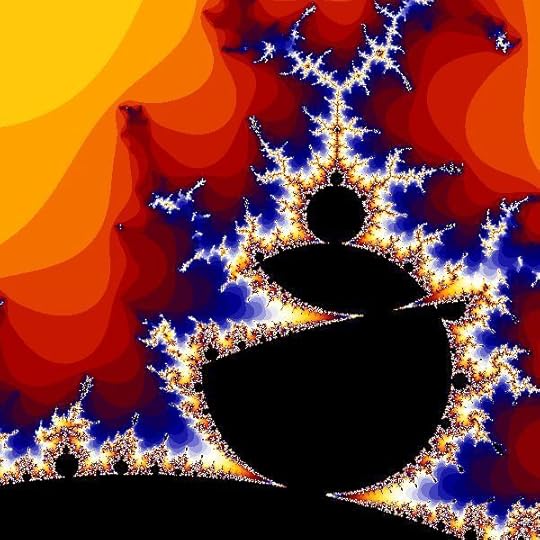
Detail of MandelCubicPacMan
The rest of this post consists of excerpts of my journal entry of January 14, 2001, regarding my meeting with Benoit. I published this as an endnote to my tome on the meaning of computation, The Lifebox, the Seashell, and the Soul, but I thought I'd post it on my blog today as well.

RudyMars
Mandelbrot is waiting for me at the end of his driveway, he's worried I might not find the house as the address on the curb is covered by snow. A white-haired balding man, stocky, somewhat diffident, he sees me, I wave, he doesn't wave back, not sure yet I'm the one he's waiting for, when I'm closer he says "Are you Rudy Rucker?" We introduce ourselves, shake hands, I tell him I'm thrilled to meet him. In the house his wife Adèle greets us, Mandelbrot disappears to take a pee I suppose, then we sit in a cold room with some armchairs. They don't seem to really heat their house. He sits on an odd modern chair with parts of it missing, a collection of black corduroy hotdogs. He wears a jacket, a vest, a shirt, trousers with a paperclip attached to the fly to make it easier to pull up and down, I guess he's 75. Rather rotund and, yes, a bit like the Mandelbrot set in his roundness and with the fuzz of hairs on his pate.
He starts talking almost right away, an incredibly dense and rich flow of information, a torrent. Fractal of course, as human conversation usually is, but of a higher than usual dimension. It's like talking to a superbeing, just as I'd hoped, like being with a Martian, his conversation a wall of sound paisley info structure, the twittering of the Great Scarab.
His wife listens attentively as we talk and from time to time she reminds him to tie up some loose thread.

RudyHorse
Mandelbrot doesn't seem overly vain as I'd heard him described by some rivals. Certainly he has good self-esteem, but I think it's well-earned and justified.
I repeatedly feel a great urge to go out and have a cigarette. The firehose-stream of information in his strong French accent I have to cock my ear and listen my hardest to process it. Conscious of his wife watching me listen to him. I imagined she's judging how well I seem to listen, and when once I smirk as he says something a bit self-aggrandizing, she catches my expression and I imagine her giving me a black mark.
He isn't clear exactly what Jeff is trying to do with the movie, how Jeff plans to fund it, what his (Mandelbrot's) role is supposed to be, etc. I explain it as best I can; we don't really expect Benoit to do much more than to say that that he doesn't find our project totally absurd. He seems to want to exact some kind of concession; at the end I have the feeling that he considers Jeff's emphasis on "infinity" to be a deal-breaker, to the extent that there might have been a deal.

RudyRockets (detail of the Rudy Set). Lower down in this post is an animated YouTube zoom to the Rockets.
I mention how much he's affected my view of the world. I mention also that I'm as excited to meet him as I was to meet Gödel. Mandelbrot says, "Oh Gödel didn't talk much, I saw him at the Institute, I was von Neumann's last student." I rejoinder, "Well, Gödel talked a lot when I saw him, I was working on something he was interested in," and Benoit is impressed.
In the event, it's not really like meeting Gödel because I'm not so young and starry-eyed that I see Mandelbrot as a mythopoetic guru. Yet it is like meeting Gödel in the sense that for these two special oasis hours midway in the long caravan of my life I'm talking to someone whom I feel to be smarter than me. An ascended master.
YouTube movie of a "Rockets" zoom into the Rudy Set.
I've been thinking some more about ways in which Mandelbrot resembled the Mandelbrot set, it's a conceit I'm bent on playing with. As I mentioned yesterday, he was rather round about the middle, even bulbous, and his clothes and his head were indeed adorned with any number of fine hairs. He appeared and disappeared from my view several times; he'd get up and leave the room and then return. Perhaps each time it was a different bud of him that came back in!
A key point in perceiving his multi-budded nature is that his wife in many ways resembles him: accent, age, attire, knowledge about his work. She was in fact a mini-Mandelbrot set hovering near the flank of the larger bud I was talking to. The two of them were connected, of course, by a tendril of love and attention, rather hard to physically see.
[Y MandelQuinticLeopard.]
At times I felt a bit of menace from Mandelbrot, as when he was repeatedly asking that we not bill the movie as being about infinity. I felt some anxiety that he might somehow do something against us if we didn't accede. He has, one imagines, a wide range of influences. What was going on here was that I was sensing the presence of the stinger at the tip of the Mandelbrot set. A stinger so fine as to be all but invisible, a stinger that, as he grew somewhat agitated, was twitching with rapid movements that made it yet harder to see. But nevertheless I could feel its whizzing passages though the air near me. Palpable menace.

RudySanskritBud
The world will miss you, Benoit. Thanks for making it a better place.
October 14, 2010
Wild West #6. Yellowstone. Ginsberg's Journals.
I've been reading a book of journals by Alan Ginsberg, edited by Gordon Ball, Journals: Early Fifties Early Sixties, Grove Press 1977. My idea is to have Alan Turing meet up with Ginsberg in Berkeley in the spring of 1955, at the time when Ginsberg was writing Howl.
I've copied out some passages that seem useful in terms of getting Allen G's character or in terms of fitting him into my novel. The photos today are from the Yellowstone portion of our recent road trip through the Wild West.

[Varicolored algae in a hot-spring stream.]
New York City, March-June, 1952
Alan gets marijuana ("T") and peyote from a friend, Bill Keck, who says the sense of God is, "When the universal order seems organized—when everything I see seems to belong to one organism, when everything about me swings, together. … With T you are observing everything in unison order harmony swinging organized organism—with peyote you are part of it."
He eats some peyote at his parents house and sits in the backyard writing notes while his relatives visit with the family inside. "…eyes closed toward light leaves in eye a golden glow hue—which darkens when you pass hand over lidded eye. It made me feel like a very transparent sort of organism."
"When the wind rushed through the grass you can see the green grass vibrating on the brown ground."
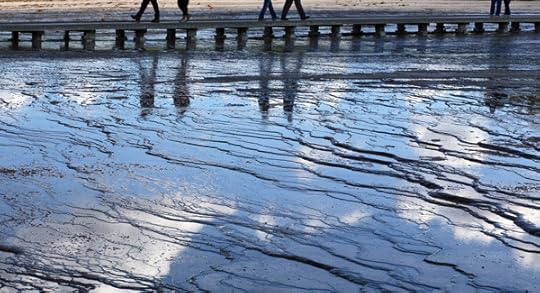
Still on that trip… "The houses around here seem so primitive, with their poor television antennae tacked on to the patched up chimney—" "And I hear relatives' honking mechanical voices in the house."
"…there's so much to say from the bottom of the heart—but not say in open—people really can't stand much reality—or me, hate to think of anyone talking back to me."
"What can you do with such a f*cking universe?"
A dream. "…I am in bed with a [lover] who covers me over with cloth on which are obscene hieroglyphs, one for each part of my body—they are supposed to act on my skin—while he watches I have sex with hieroglyphs."

[Car mirror reflection of a U-Hal van with Mt. Rushmore painted on the side, seen in the parking lot for Old Faithful.]
In the Yucatan, Mexico, 1954
He dreams a movie of William Burroughs and reconstructs the dream, which is rather apposite for my novel.
"Bill in Europe—but can't remember the dream O flat horrible reality closing in at morn after night of spectacles…Bill is shadowed by a spy from the future—spy from another dimension in hideous 3rd class train ride—set in background of Europe in the rain and decay…involving cross-passages of time. Fragments of a great 'routine.' Bill looks frightened—realizes he's been followed all along … Then—great change—a look of weariness & boredom, ennui, powerlessness and resentment. Deenergized. Then rage, a look of great annoyance—He lapses into a kind of insanity … Fate or the future was after him with its rational inanity—his insanity defeats their plans—Bill still conscious playing the routine. Like the routine which felled him laughing on kitchen floor…in N.Y."
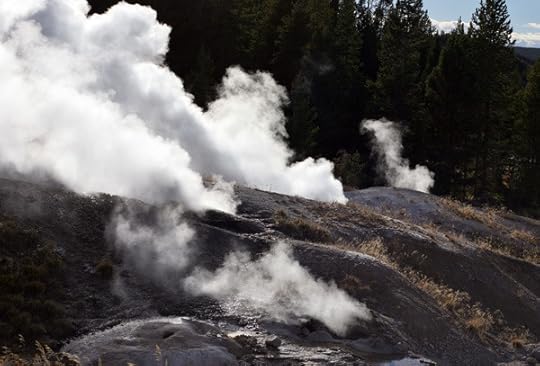
[The steaming vents like portals to the underworld.]
In Uxmal alone. "Chichén—the main kick was the wild acoustic—somewhere in the middle of all these buildings is a place where you can clap your hands and be heard in heaven."
"…only intensest writing is interesting, in which whole life direction is poured for profusion of image & care of surface and stipple & and sensual muscle of soul river thought."
Worrying about my fate again—that a small breeze of nostalgia fluttered in my heart, thinking a moment past I had someone in the room I loved with me—no ghosts—a man of flesh to talk to and hug."
"Sudden clearing where the sunlite bursts down as a great white shower."

[People waiting for Old Faithful to spout.]
Visiting on the finca (ranch) of a woman he's befriended, Karena Shields. "All the Jungle: all these rocky ruins: And suddenly in the ease and lethargy of monthlong guesthood on the ranch the singleminded conception of a vast Unfathomable god—and writing, the gift of writing thought seems like a candle in the wood."
He thinks about the reporters at U.P. (United Press) "…thinking how feeble & scrawny those reporters are in their nests, thinking they are men of action, all they do is sit up at their typewriters full of sharpness or wiseacre of cynical knowledge of limited situations priding themselves on scrawny specialties of knowledge like Bullfighting or Railroads etc. & drinking at nite, like fat short man of U.P. I spoke to, full of defensive own paltry pride, small lives up in the News building, their whole actual horizon."
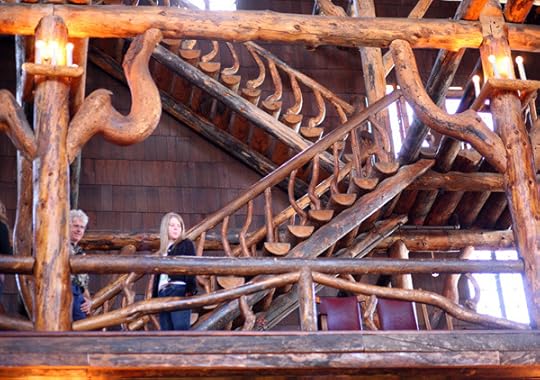
[The awesomely gnarly staircase in the Old Faithful Lodge.]
Mar 23, 1953, beautiful written Sketch of Salto de Agua, using many unusual or coined words. "tinred & tile rust roofs" "sparsely dotted thatchroofs on little hill on other side" "vasty armadas of white fragmentary clouds in bright sky" "recurring crow of cocks from this side and that challenging and responding in various cockly hoarse tones as if the existed in a world of pure intuitive sound communicating to anonymous hidden familiar chickensouls from hill to hill."
That evening he sits on the bridge there, "watching moon move over the hill you can see it rising and follow its destination thru the clear dimension of the sky in a slow circle from hill on one horizon to mountain on other, having the whole sky spread out unbroken but by stars in all 360 directions." [I saw something like this one night camping alone on a hill top in Big Sur.]

[My old painting, "Big Sur", oil, 30" by 24", August, 2000. Finding the North Star via the Big Dipper, I noticed how Earth's turning around the axis through this Pole was bringing up the moon and bringing down the sun. The flies bit me.]
Still in Salto de Agua. "The Kiosk proprietor a civilized looking citizen in a disgusting sort of way—acne and fatso glasses."
Back on the Shields finca, April 16, 1954, Good Friday. "& palmtrees appearing again in the balmy wind presaging a rain—shifting their fronds in the wind with a dry soft rattle sound, so much like animal hairy windmills—insectlike in fact, like monstrous insects long white bodies encased in scales and at the top conglomerated in the head nerve center all these rattly animal feelers that move lethargically in in the direction of the wind, settling & unsettling as in water."

[The tourists in the steam like shades in the afterworld.]
"The word Time—Like a great silver wall blocking the sky… One might sit in this Chiapas recording the appearance of time, like painting—the palmtree so much suggesting an animal force spraying up in slow time."
Dream of walking around New York City with Jack Kerouac. "Impression of the unknown miles of movies & bridges & houses & alien life in Brooklyn, how one could go walking alone (or with others) not to explore but to enjoy & be awed by the vast human scenery just as one goes walking thru mountains in awe. For kicks, not to map the streets."

[Yellowstone Lake]
Back in California, 1954.
"Of an eternity we have a number of score of years … I have had several months near joy, and of that perhaps one day doing what I inmost want and of that a minute of perfection."

On June 17, 2954, he's staying stay with Neal Cassady and his family in Monte Sereno, near San Jose, California. He's in love with Neal, mooning over him. "I feel like a strange idiot, standing there among wife & children all to whom he gives needs of affection and attention, aching for some special side extra sacrifice of attention to me—as if like some nowhere evil beast intruding I were competing for his care with his own children & wife and job which seems to occupy energize bore & tire him."
He drafts a poem called "Serenade" with this phrase, "The bomb appeared intolerable, light and radiance, and afterwards the grey world appeared as a ghost."
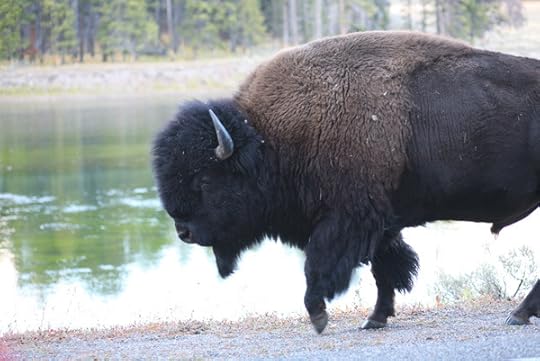
In Berkeley, Fall, 1955.
Allen writes some fourteen-syllable haikus.
"The madman
emerges from the movies:
the street at lunchtime."
"The moon over the roof,
worms in the garden.
I rent this house."
Rudy Rucker's Blog
- Rudy Rucker's profile
- 583 followers






